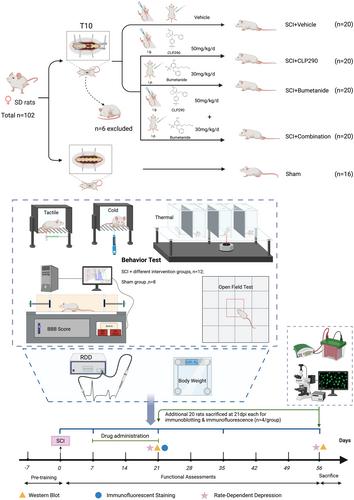We aimed to explore whether the combination of CLP290 and bumetanide maximally improves neuropathic pain following spinal cord injury (SCI) and its possible molecular mechanism.
Rats were randomly divided into five groups: Sham, SCI + vehicle, SCI + CLP290, SCI + bumetanide, and SCI + combination (CLP290 + bumetanide). Drug administration commenced on the 7th day post-injury (7 dpi) and continued for 14 days. All rats underwent behavioral assessments for 56 days to comprehensively evaluate the effects of interventions on mechanical pain, thermal pain, cold pain, motor function, and other relevant parameters. Electrophysiological assessments, immunoblotting, and immunofluorescence detection were performed at different timepoints post-injury, with a specific focus on the expression and changes of KCC2 and NKCC1 proteins in the lumbar enlargement of the spinal cord.
CLP290 and bumetanide alleviated SCI-associated hypersensitivity and locomotor function, with the combination providing enhanced recovery. The combined treatment group exhibited the most significant improvement in restoring Rate-Dependent Depression (RDD) levels. In the combined treatment group and the two individual drug administration groups, the upregulation of potassium chloride cotransporter 2 (K+-Cl−cotransporter 2, KCC2) expression and downregulation of sodium potassium chloride cotransporter 1 (Na+-K+-Cl−cotransporter 1, NKCC1) expression in the lumbar enlargement area resulted in a significant increase in the KCC2/NKCC1 ratio compared to the SCI + vehicle group, with the most pronounced improvement seen in the combined treatment group. Compared to the SCI + vehicle group, the SCI + bumetanide group showed no significant paw withdrawal thermal latency (PWTL) improvement at 21 and 35 dpi, but a notable enhancement at 56 dpi. In contrast, the SCI + CLP290 group significantly improved PWTL at 21 days, with non-significant changes at 35 and 56 days. At 21 dpi, KCC2 expression was marginally higher in monotherapy groups versus SCI + vehicle, but not significantly. At 56 dpi, only the SCI + bumetanide group showed a significant difference in KCC2 expression compared to the control group.
Combined application of CLP290 and bumetanide effectively increases the ratio of KCC2/NKCC1, restores RDD levels, enhances GABAA receptor-mediated inhibitory function in the spinal cord, and relieves neuropathic pain in SCI; Bumetanide significantly improves neuropathic pain in the long term, whereas CLP290 demonstrates a notable short-term effect.



